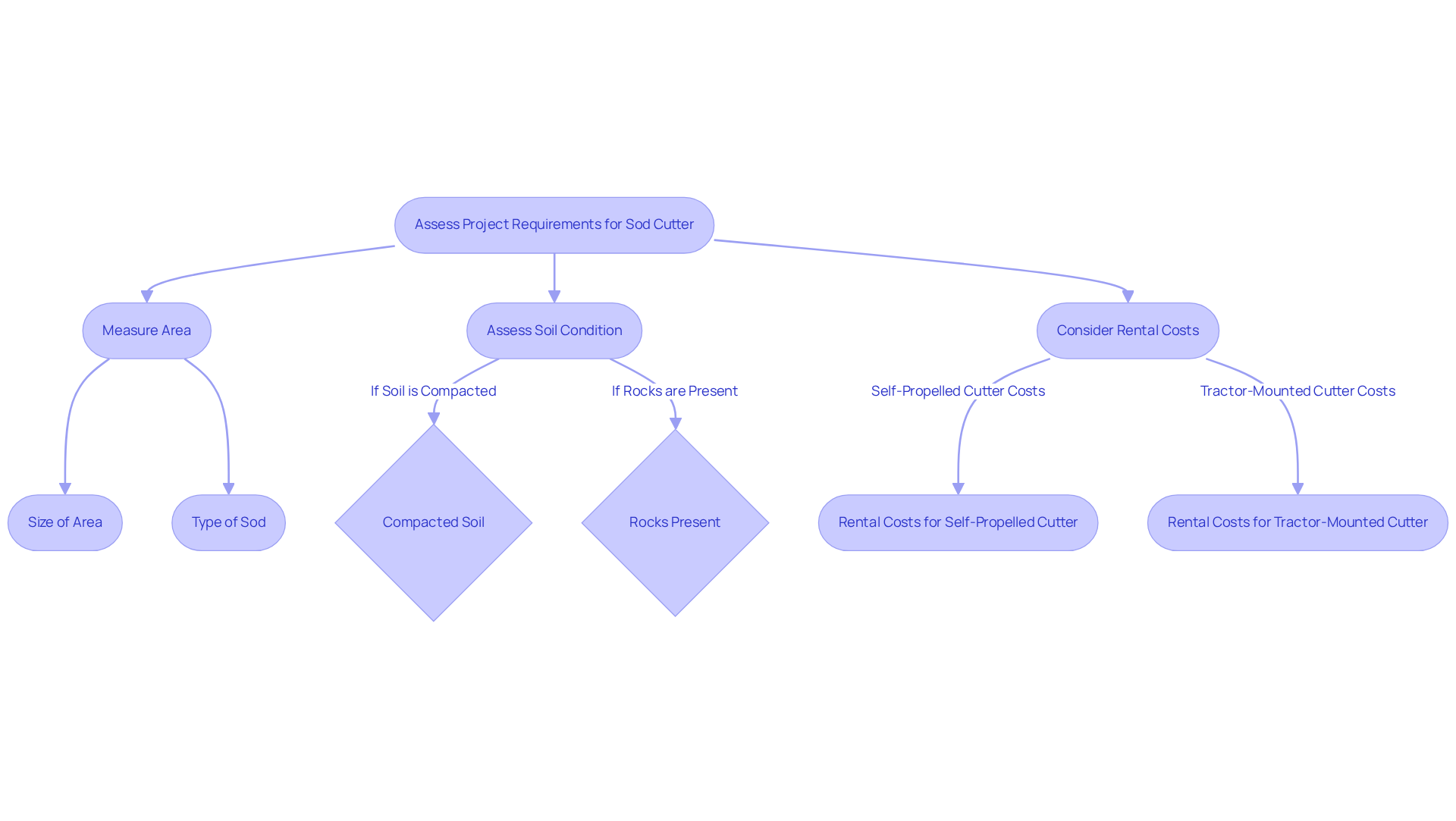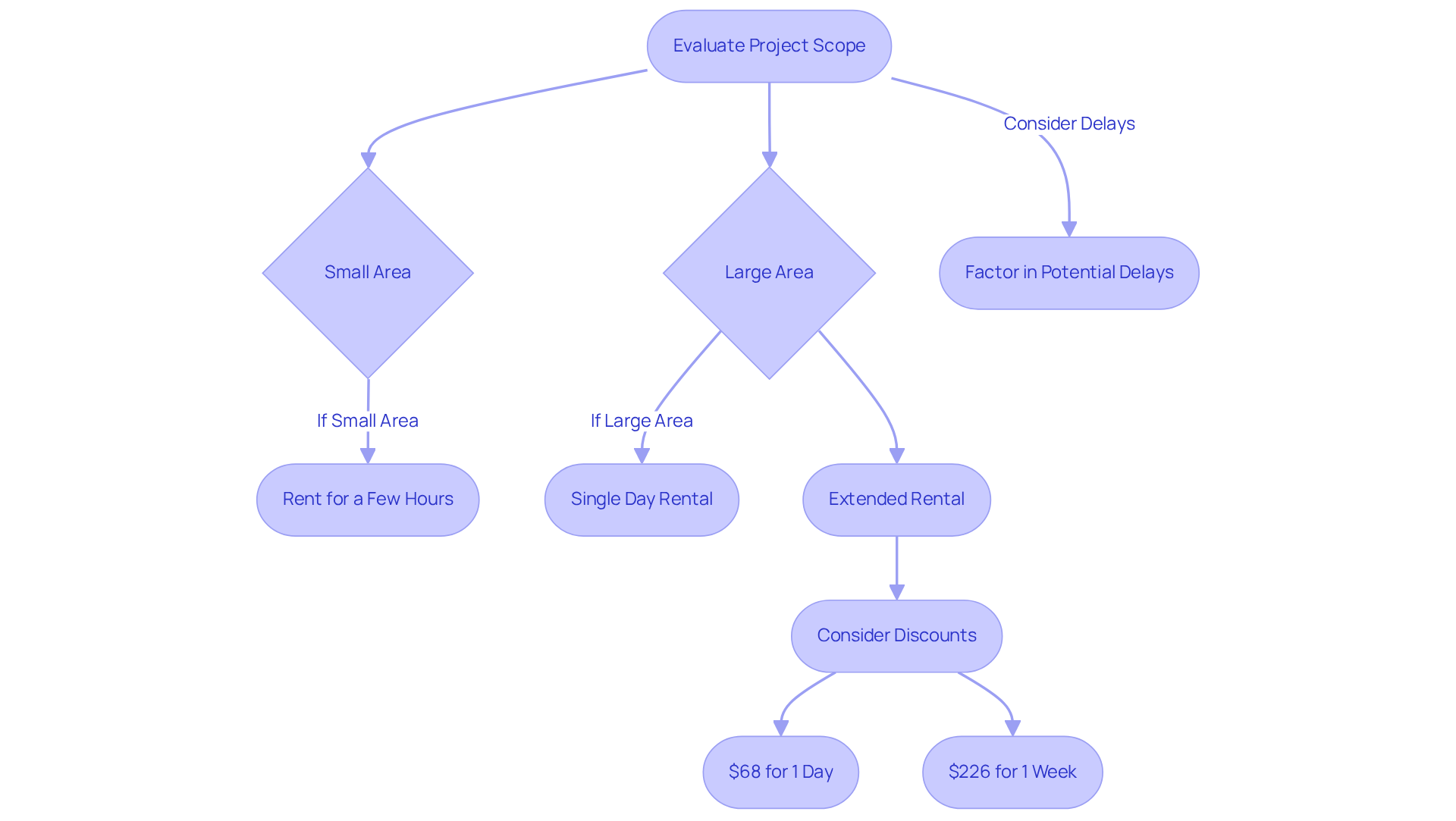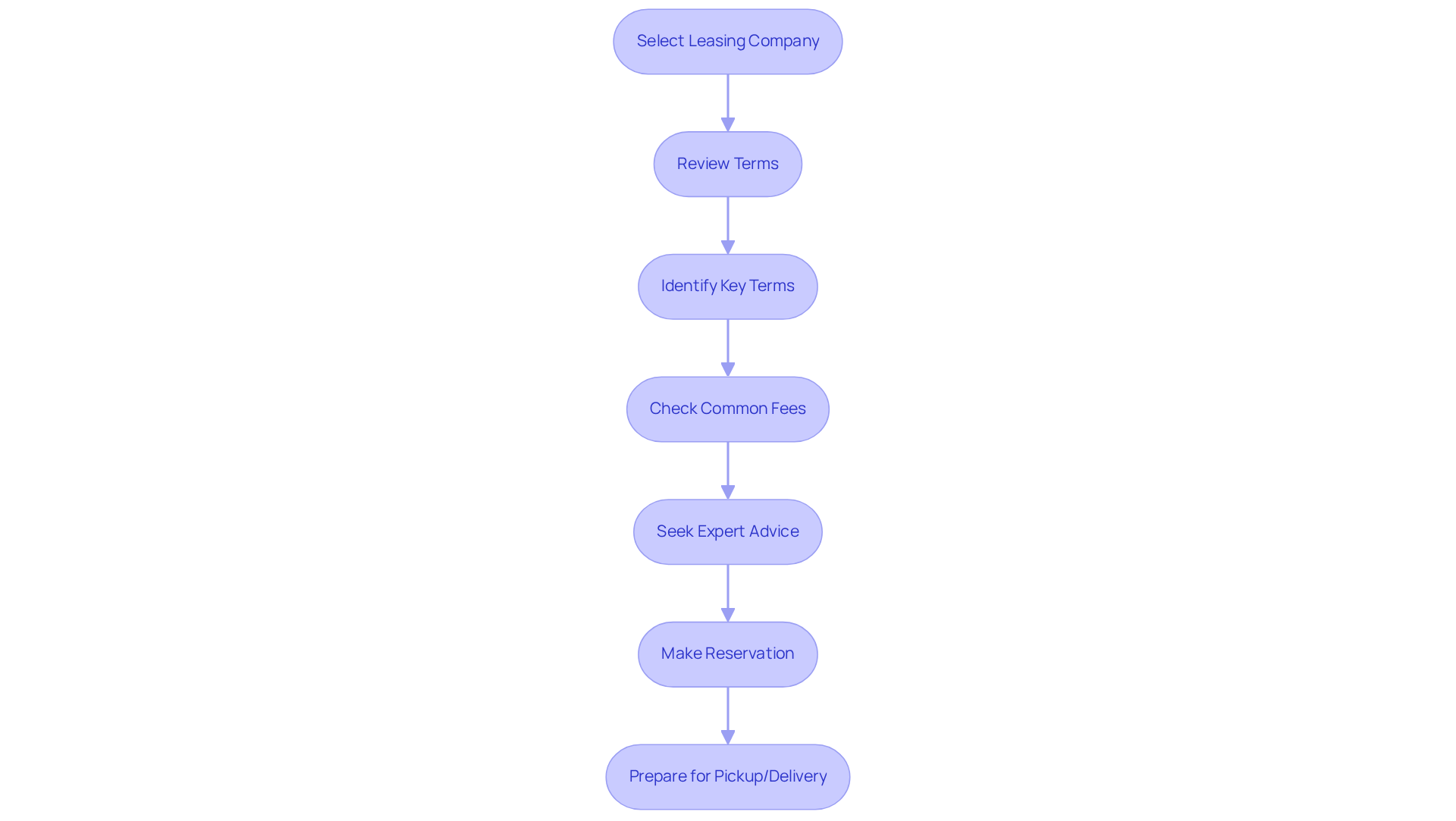Overview
To effectively assess the rental of a sod cutter, it is essential to evaluate the project requirements, including:
- Area size
- Soil condition
- Rental duration
These factors significantly influence both the choice of equipment and the associated pricing. Rental costs typically range from $70 to $120 per day, with potential discounts for extended rental periods. Additionally, comparing options and finalizing agreements is crucial for securing an efficient rental experience. By understanding these elements, you position yourself for a successful project outcome.
Key Highlights:
- Measure the area for sod cutting accurately, considering the type of sod and size, to determine the appropriate equipment.
- Self-propelled mowers are suitable for average lawns, while tractor-mounted machines are better for larger areas, costing $80-$100 per day to rent.
- Assess soil condition and depth requirements, as compacted ground or rocks may necessitate more powerful sod machines.
- The construction equipment rental market is projected to grow at 6.2% CAGR, indicating rising demand for sod cutting machines.
- Evaluate rental duration based on project size; discounts may apply for extended rentals, e.g., $226 for a week compared to $68 for a day.
- Consider potential delays (e.g., weather) that may extend rental needs and plan accordingly.
- Rental prices for sod cutters range from $70 to $120 daily, with powered models generally costing more.
- Create a comparison chart to visualise rental options, including prices, tool types, and additional fees.
- Review rental agreements carefully, focusing on lease duration, pricing, return policies, and any hidden fees.
- Retain a copy of the signed agreement and prepare necessary documentation for pickup or delivery.
Introduction
Navigating the world of equipment rentals can be a daunting task, particularly when it involves specialized tools such as sod cutters. With the construction equipment rental market on the rise, it is essential to understand how to effectively rent a sod cutter, whether you are a novice DIYer or a seasoned landscaper.
This guide explores the crucial steps and considerations for selecting the right sod cutter for any project, including:
- Measuring your lawn
- Comparing rental prices
- Finalizing agreements
Furthermore, how can one ensure they make the most informed choice while avoiding unexpected costs and complications?
Assess Your Project Requirements for a Sod Cutter
Begin by accurately measuring the area designated for sod cutting. This process involves not only noting the dimensions but also considering the specific type of sod involved. Understanding the size of the area is crucial, as it directly influences the choice of equipment. For example, a self-propelled walk-behind mower is ideal for average-sized lawns, while larger areas may require a tractor-mounted machine. This type of equipment is designed for extensive land coverage and typically costs between $80 and $100 per day to rent, leading to the question of how much to rent a sod cutter along with the additional tractor rental fee of $260 to $360.
Next, assess the soil condition. If the ground is compacted or contains rocks, a more powerful sod machine will be necessary to ensure effective removal. The depth of the cut is another essential factor; various projects may necessitate different depths, which can influence the kind of tool you select. By taking these considerations into account, you can ensure optimal performance from your equipment.
Current trends indicate that the construction equipment rental market is expanding, with a projected growth rate of 6.2% CAGR from 2025 to 2034 and an overall market value exceeding $147.4 billion in 2024. This growth signifies a rising demand for effective implements such as sod machines, which can greatly simplify the grass removal process. Furthermore, utilizing tools like Google Maps can aid in accurately measuring residential lawns. By carefully considering these factors, you can choose the most appropriate sod machine for your task, ultimately improving both efficiency and effectiveness.

Evaluate Rental Duration and Frequency
When considering how much to rent a sod cutter for your project, it is vital to evaluate the scope of your project. For smaller areas, a few hours may suffice, while larger tasks might require a full day or more. Determine if the sod cutter will be necessary for multiple days or just a single use. Many leasing companies, such as EZ Equipment Rental, offer discounts for extended rental periods, making it advantageous to meticulously assess your timeline. For example, renting for a week can lead to significant savings, with rates starting at $226 for a week compared to $68 for a single day.
Additionally, it is crucial to factor in potential delays that could extend your rental needs, such as adverse weather conditions or unforeseen challenges. As project managers often emphasize, a well-organized timeline is essential for effective equipment leasing planning, ensuring that you have the necessary tools available when required. Remember, how much to rent a sod cutter is determined by a minimum rental duration of four hours. Utilizing the Classen Gear-Drive Sod Device, designed with vibration-reducing technology, can enhance your efficiency in completing the task.
In conclusion, understanding your project requirements and timeline is key to optimizing your equipment rental experience. Take advantage of the benefits offered by rental companies, and ensure you are prepared for any challenges that may arise. By planning ahead, you can secure the right equipment and achieve your project goals with confidence.

Compare Rental Prices and Options
To effectively compare rental prices, especially how much to rent a sod cutter, start by researching local rental companies such as EZ Equipment Rental, Home Depot, and Sunbelt Rentals. Examine the varieties of sod devices available, noting the distinctions between manual and powered models. When you want to know how much to rent a sod cutter, rental costs typically range from $70 to $120 each day, with powered sod devices generally commanding a higher price due to their enhanced functionalities. For instance, when considering how much to rent a sod cutter, the average cost to hire a powered sod machine is approximately $94, while manual alternatives may be somewhat less expensive, often falling between $70 and $90.
When evaluating leasing options, consider the duration of the lease, as longer terms can lead to discounts. Furthermore, inquire about any additional costs that could impact your budget, such as delivery fees, which can range from $65 to $230 depending on your location and the quantity ordered, as well as potential deposits.
Creating a comparison chart can be an invaluable tool to visualize your options. Include key factors such as rental prices, tool types, and any additional fees. This approach will assist you in making an informed choice that aligns with your requirements and budget constraints. Remember, selecting the appropriate sod tool not only influences your immediate expenses but also impacts the efficiency and quality of your lawn renovation project.

Finalize Your Rental Agreement and Reservation
After selecting a leasing company and confirming the sod cutter you require, the subsequent step is to finalize your leasing agreement. Begin by meticulously reviewing the terms, focusing on critical elements such as lease duration, pricing, and how much to rent a sod cutter along with any applicable additional charges. It is essential to pay close attention to the return policy and your maintenance responsibilities during the lease period, as these factors can significantly influence your overall experience.
To ensure clarity, consider these tips:
- Key Terms: Identify terms related to late fees, damage waivers, and insurance coverage. A solid understanding of these aspects can help you avoid unexpected costs.
- Common Fees: Be vigilant about potential fees, including delivery charges, cleaning fees, or penalties for late returns. Budgeting and cost-saving measures are paramount for equipment leasing businesses, making it crucial to comprehend how much to rent a sod cutter for effective project budget management.
- Expert Advice: Legal experts strongly recommend seeking clarification on any terms that appear vague or confusing. As one legal advisor noted, "Comprehending the subtleties of lease agreements can protect you from expensive misconceptions in the future."
Once you have confirmed all details and feel assured with the agreement, move forward to make your reservation. This can typically be done online or by directly contacting the leasing company. Remember to retain a copy of the signed agreement for your records, as it will be vital for reference throughout the rental period. Finally, prepare for the pickup or delivery of your sod cutter, ensuring that you have all necessary documentation ready.

Conclusion
Effectively renting a sod cutter can significantly streamline your lawn renovation project. By thoroughly assessing your specific requirements—such as the size of the area and soil conditions—you can select the right equipment that enhances both efficiency and effectiveness. This foundational step ensures that you are well-prepared to tackle the task at hand.
Key considerations, including evaluating rental duration, comparing prices, and finalizing your rental agreement, play a crucial role in optimizing your experience. Taking the time to research local rental companies and understanding the various models available allows you to make informed decisions that align with your budget and project scope. Furthermore, being proactive about potential delays and extra costs can further safeguard your investment.
Ultimately, renting a sod cutter transcends merely securing equipment; it involves equipping yourself with the knowledge and tools necessary to achieve your project goals. By following these steps and utilizing available resources, anyone can navigate the rental process with confidence, ensuring a successful outcome for their lawn renovation efforts. Embrace the opportunity to transform your outdoor space efficiently and effectively, knowing that a well-planned approach can lead to outstanding results.
Frequently Asked Questions
How do I begin assessing my project requirements for a sod cutter?
Start by accurately measuring the area designated for sod cutting, noting the dimensions and the specific type of sod involved. Understanding the size of the area is crucial for choosing the right equipment.
What type of sod cutter should I use for different lawn sizes?
For average-sized lawns, a self-propelled walk-behind mower is ideal. For larger areas, a tractor-mounted machine is recommended, as it is designed for extensive land coverage.
How much does it cost to rent a sod cutter?
Renting a sod cutter typically costs between $80 and $100 per day, in addition to the tractor rental fee, which ranges from $260 to $360.
What factors should I consider regarding soil condition when choosing a sod cutter?
Assess the soil condition by checking if the ground is compacted or contains rocks. A more powerful sod machine will be necessary for effective removal in such cases.
How does the depth of the cut affect my choice of sod cutter?
Different projects may require varying depths of cut, which can influence the type of tool you select. It's important to consider the depth needed for your specific project.
What are the current trends in the construction equipment rental market?
The construction equipment rental market is expanding, with a projected growth rate of 6.2% CAGR from 2025 to 2034, and an overall market value exceeding $147.4 billion in 2024.
How can I accurately measure my residential lawn?
Utilizing tools like Google Maps can aid in accurately measuring residential lawns, helping you determine the appropriate size for your sod cutter.
Why is it important to consider these factors when choosing a sod machine?
By carefully considering the area size, soil condition, and cutting depth, you can ensure optimal performance from your equipment, ultimately improving both efficiency and effectiveness in the grass removal process.




